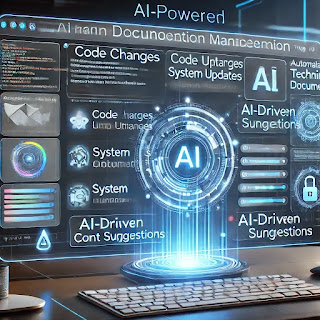How AI is Transforming Legacy Documentation Updates
Maintaining accurate and up-to-date documentation is a crucial but time-consuming task for developers. Legacy documentation often becomes outdated due to frequent code changes, system updates, and evolving best practices. AI-powered solutions are now revolutionizing the way documentation is managed, ensuring accuracy, reducing manual effort, and improving developer productivity. Let’s explore how AI is reshaping documentation updates.
Challenges of Legacy Documentation
Legacy documentation comes with several challenges that make manual updates inefficient:
- Outdated Information – As technology evolves, older documentation often fails to reflect the latest code changes.
- Manual Effort Required – Updating documentation requires significant time and effort, diverting developers from core tasks.
- Inconsistencies Across Documents – When multiple sources exist, ensuring uniform updates across all documentation becomes difficult.
- Tracking Changes is Complex – Identifying what needs updating in large documentation sets can be overwhelming.
AI-driven solutions address these issues by automating updates and ensuring consistency.
How AI Detects Documentation Changes
AI tools leverage real-time data analysis and automation to detect changes in technical content:
- Code Monitoring – AI continuously tracks codebase modifications and identifies areas requiring documentation updates.
- Outdated Reference Detection – AI detects obsolete references and recommends necessary corrections.
- API and System Analysis – AI scans API modifications, ensuring integration guides remain relevant.
- Consistency Checks – AI verifies terminology, formatting, and versioning to maintain uniformity.
These capabilities help keep documentation aligned with real-world implementations.
Automating Documentation Updates with AI
AI-powered automation is streamlining the documentation update process:
- Generating Missing Content – AI can draft missing sections or summarize changes in an easy-to-understand format.
- Suggesting Contextual Improvements – AI analyzes content clarity and offers refinements for better comprehension.
- Version Control Integration – AI tools sync with repositories like GitHub to update documentation alongside code changes.
- Automating Formatting and Structuring – AI ensures documents follow a standard structure, improving readability.
By integrating AI, companies can reduce documentation errors and improve efficiency.
Reducing Developer Workload
AI-driven documentation management significantly lightens the burden on developers:
- Minimizing Manual Edits – Automated updates reduce the need for developers to manually rewrite documentation.
- Preventing Documentation Backlogs – AI ensures updates happen in real-time, eliminating outdated content.
- Maintaining Accuracy Across Systems – AI harmonizes documentation across platforms and tools.
- Improving Knowledge Transfer – Updated and well-structured documentation accelerates onboarding and troubleshooting.
With AI, developers can focus more on coding and problem-solving rather than spending time on documentation updates.
Ensuring Documentation Accuracy with AI
AI tools improve documentation quality by eliminating errors and inconsistencies:
- Error Detection and Fixes – AI identifies grammatical mistakes, typos, and broken links.
- Enhanced Readability – AI ensures documentation is concise and user-friendly.
- Real-time Validation – AI cross-checks documentation accuracy against the current system state.
- Automated Compliance Checks – AI ensures documentation meets industry standards and best practices.
These enhancements lead to a more reliable and professional documentation experience.
AI-Powered Content Generation and Searchability
AI doesn’t just update existing documentation—it can also create new content and improve search functionality:
- Generating Summaries and Explanations – AI extracts key information and generates easy-to-digest summaries.
- Building Structured Knowledge Bases – AI organizes documentation for better accessibility.
- Improving Search Capabilities – AI-driven search engines provide precise and context-aware results.
- Aligning Documentation with Best Practices – AI ensures that documentation is structured and optimized for learning.
AI-driven content generation helps developers quickly find the information they need.
Integrating AI into Documentation Workflows
AI tools seamlessly integrate with existing developer workflows:
- Syncing with DevOps Pipelines – AI updates documentation alongside deployment cycles.
- Connecting with API Documentation Tools – AI ensures API guides remain accurate and up to date.
- Automating Documentation Versioning – AI keeps track of documentation updates over different software versions.
- Supporting Markdown and Wiki Platforms – AI integrates with commonly used documentation platforms.
By embedding AI into documentation workflows, organizations can achieve continuous improvement in documentation quality.
The Future of AI in Documentation
AI is set to further revolutionize documentation management:
- Continuous Learning from Feedback – AI refines suggestions based on user interactions.
- Multilingual Support – AI assists in translating documentation for global accessibility.
- Intelligent Search and Recommendations – AI improves search accuracy for better knowledge discovery.
- Automated Knowledge Graphs – AI builds interlinked documentation networks for deeper insights.
The future of documentation is smart, automated, and developer-friendly.
Final Thoughts
AI is transforming the way organizations manage documentation by automating updates, enhancing accuracy, and reducing developer workload. Legacy documentation no longer needs to be a bottleneck—AI ensures that technical content remains relevant, consistent, and easy to maintain.
Are you ready to revolutionize your documentation workflow? AI-powered solutions like Doc-E.ai can help you modernize your approach. 🚀

.jpg)

Comments
Post a Comment